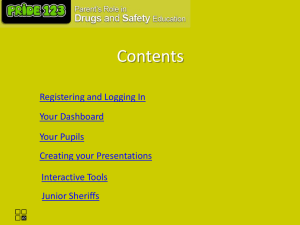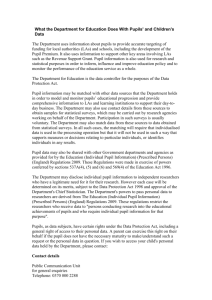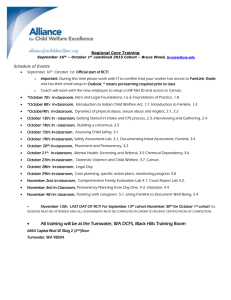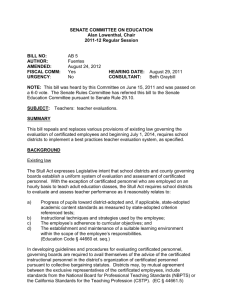Online Courses
advertisement
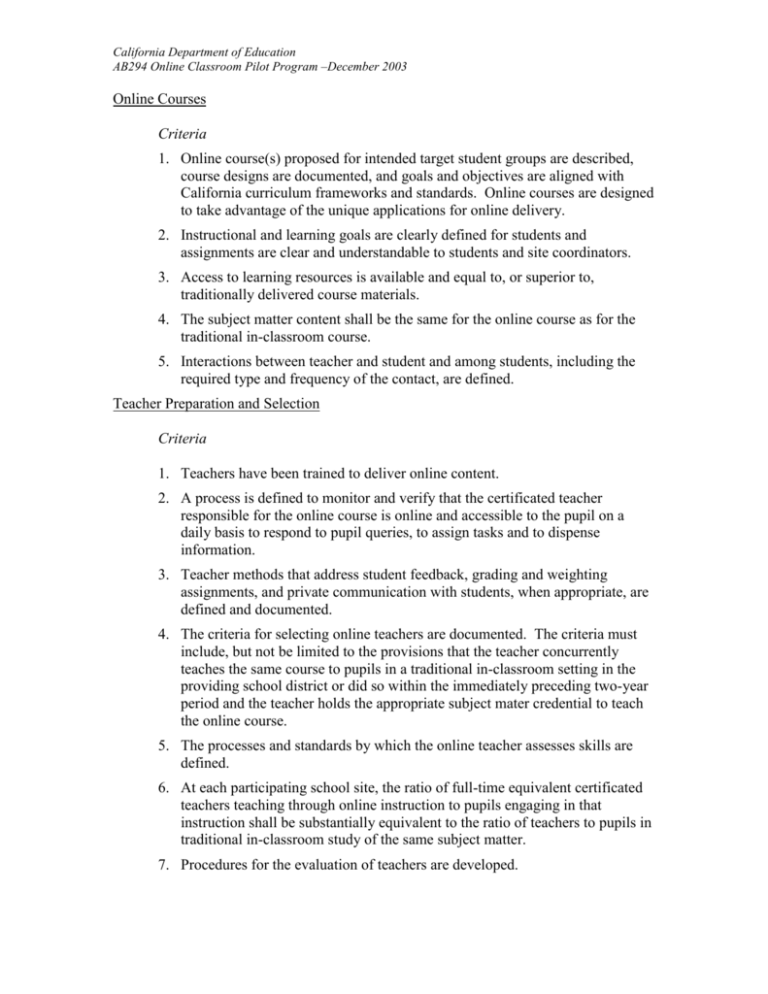
California Department of Education AB294 Online Classroom Pilot Program –December 2003 Online Courses Criteria 1. Online course(s) proposed for intended target student groups are described, course designs are documented, and goals and objectives are aligned with California curriculum frameworks and standards. Online courses are designed to take advantage of the unique applications for online delivery. 2. Instructional and learning goals are clearly defined for students and assignments are clear and understandable to students and site coordinators. 3. Access to learning resources is available and equal to, or superior to, traditionally delivered course materials. 4. The subject matter content shall be the same for the online course as for the traditional in-classroom course. 5. Interactions between teacher and student and among students, including the required type and frequency of the contact, are defined. Teacher Preparation and Selection Criteria 1. Teachers have been trained to deliver online content. 2. A process is defined to monitor and verify that the certificated teacher responsible for the online course is online and accessible to the pupil on a daily basis to respond to pupil queries, to assign tasks and to dispense information. 3. Teacher methods that address student feedback, grading and weighting assignments, and private communication with students, when appropriate, are defined and documented. 4. The criteria for selecting online teachers are documented. The criteria must include, but not be limited to the provisions that the teacher concurrently teaches the same course to pupils in a traditional in-classroom setting in the providing school district or did so within the immediately preceding two-year period and the teacher holds the appropriate subject mater credential to teach the online course. 5. The processes and standards by which the online teacher assesses skills are defined. 6. At each participating school site, the ratio of full-time equivalent certificated teachers teaching through online instruction to pupils engaging in that instruction shall be substantially equivalent to the ratio of teachers to pupils in traditional in-classroom study of the same subject matter. 7. Procedures for the evaluation of teachers are developed. California Department of Education AB294 Online Classroom Pilot Program –December 2003 Policies and Procedures for Supporting Online Courses Criteria 1. Policies for maintaining the integrity of course tests are documented. A school district of a school site that offers online classroom programs pursuant to this section shall verify that online pupils take examinations by proctor or that other reliable methods are used to ensure test integrity and that there is a clear record of pupil work, using the same method of documentation and assessment as in a traditional in-classroom course. 2. Student selection policies and procedures regarding pupil priority and selection for online courses are defined. A pupil shall not be assigned to an online course, unless the pupil voluntarily elects to participate in the online course. The parent or guardian of the pupil shall provide written consent before the pupil may participate in an online course. 3. Policies and procedures for obtaining informed consent from both the parent and pupil regarding course enrollment are established. 4. Processes for documenting student work in online courses are developed. 5. The process for documenting records to verify the time that pupils taking online courses spend online and related activities is developed. Also, the school district shall also maintain records verifying the time the instructor was online. 6. A marketing plan to reach out to target students and to the community is prepared. 7. A process defining how the online class size will be monitored and limited to the average class size for similar courses in high schools of the school district offering the online classroom program is developed. 8. Provisions for meeting Americans with Disabilities Act (ADA) criteria are defined. 9. Procedures to guarantee security of student work are developed. 10. A policy is developed to address equal access for students to computers, Internet connections, and other resources necessary for taking a course online. 11. Quality control measures are in place to identify effective instructional practices. 12. The training/orientation for school administrators to prepare them for administering online courses is identified. 13. A policy for online teacher selection is documented. 14. The monitoring plan for student chat sessions and/or student-to-student interaction is in place. 15. Evaluation of the online courses includes a comparison with traditional inclassroom courses. 1 California Department of Education AB294 Online Classroom Pilot Program –December 2003 Student Support Criteria 1. A screening process that ensures that online course students have the required level of skills, motivation and commitment to learn online is developed. 2. Teacher and student plans for intervention and student recovery in case of student failure or dropout are in place. 3. A process for providing students with information about online courses (e.g., prerequisites, syllabus, workload, credit, and transferability options) is developed. 4. Access to online teachers, counseling, guidance, and technical support services students may need as a participant in an online course is defined, including the provision of onsite support for pupils taking online courses. Technical Support Criteria 1. Technical support is available to the teachers, facilitators and students for online courses. 2. Site facilitators/coordinators are trained and available for supporting online courses. Technology Infrastructure Criteria 1. The agency technology plan addresses the delivery of online courses. 2. The appropriate level of technology needed at the site at which students will be taking the online course is available. 3. The delivery method for online course delivery to the student site is defined, the technology is in place, and the online learning resources are available. 4. Teachers have appropriate access to computers, Internet connections, and other resources necessary for teaching a course online. Accounting Criteria 1. A system that records and manages student contacts by the teacher or school is in place. 2. The capability of student information systems to capture and manage data for all fiscal and student attendance, grades and online course participation is explained and documented. 2


